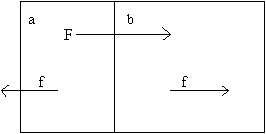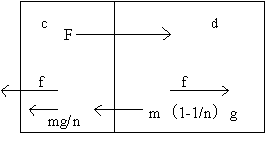Contents in this chapter are acquired by my unique thinking like other contents. I read books on the theory of relativity. But I have not seen the same point of an argument about the general theory of relativity and acceleration of spaceships.
Even if we can give a spaceship big impulse by a new revolutionary engine and the impulse gives it big G, human beings in the spaceship can not endure the G and the limit of acceleration arises, which can be a big problem. I agree the essence of gravitation is accelerated motion as well as the essence of spaceships' motions. However, when the force which spreads through human beings from their spaceship increase gradually and the human beings and their spaceship move at the same accelerated velocity, I think the human beings can move freely, which are explained below.
When a rocket is launched, astronauts experience big G (the load). I think this phenomenon occurs whenever the rocket's upper accelerated motion bumps the wall of down gravitation. I think force bumps force and that makes a load.
From our homely experience we feel heavily when we stretch arms, and it is because of our body giving upper force against the down gravitation of arms. We feel heavily with legs because normal force from the ground bump the down gravitation at the legs.
When force spreading from a train through human beings in the train increases gradually, G acts on our bodies, too. That can be described as follows. It can be thought that the attraction of gravity acting on objects on the Earth is the resultant force of universal gravitation from every part of the Earth; there are ingredients of the gravitation which direction is opposite to the train, and the ingredients bump the force which spread from the train. Also, the direction of the moving train isn't fully perpendicular to the direction of the Earth's center and its influence can be thought of.
And when human beings free-fall, though the gravity is working, the human beings can move freely, for the reason that there are no bumps of force. The reason is that there is no force which bumps the gravity.
Then, what is G defined? Define xG as a load when accelerated in xg on the 1g Earth.
Let's define more generally xyG as a load when accelerated in xg in opposition to yg force.
With acceptance on this point, let's think about the G which acts on human beings when force spreads through them from their spaceship, the force increases gradually and they and their spaceship move at the same accelerated velocity.
In this case, the spaceship receives reactions of the force which pushes the human beings. Therefore, the spaceship's propulsive force bumps the reactions and G occurs.
But only the force spreading from the spaceship acts on them and there are no bumps between force and force. Because they are in the deep space. Therefore, as G doesn't occur, the human beings can move freely. In this case, they are in the same condition as the free fall.
But, when force spreading from the spaceship through the human beings increase rapidly, I think big loads act on the human bodies by the changes of magnitude of the force.
On the other hand, it could be a question whether G occurs in the process that the force from the spaceship spread through the human bodies. I try to think about this problem.
Suppose mass of a human body "m" and that we divide it in 2 into n'th part "a" and part of the remainder "b" and force from a spaceship spreads through n'th part "a" at first. This is shown in figure 5.
Figure 5

As above-mentioned, in this case G doesn't occur because there are no bumps between force and force in " the part of the remainder".
A problem lies in G in n'th part.
I will make a dynamic equation in regard to this. Suppose the accelerated velocity "alpha", the normal force "f", the force from the spaceship "F". In this case, f functions like the gravity. Then, [8][9] are available.
From [8][9], you ask xy and the answer is [10]. That is, the more closely "n" approaches "1", namely the bigger part of the human body is combined, then, the smaller G is.
To compare with above mentioned I try to think about the G acting on human bodies when rockets are launched on the Earth. In this case, too, you make mass of the human body "m" and you suppose that it divides in 2 into n'th part "c" and the part of the remainder "d" and the force from the spaceship spreads through n'th part "c" at first. I show them in figure 6.
Figure 6

In this case, the gravity rightly acts on the part of the remainder and force bumps, then, G occurs.
I make a dynamics equation in regard to this. Making the accelerated velocity "alpha",the normal force "f", the force from the spaceship "F", [11][12] is available. From [11][12], you ask xy, then, [13] is available.
In the same way, as for n'th part, [14][15] is available. Also, [16] is clear about the whole human body with mass m. From [14][15][16] eliminating F and f, and ask xy, then, [17] is available.
From[13][17],the more closely n approaches 1, the smaller G is, but G doesn't become smaller than alpha/g.
From above mentioned, it is clear human bodies' movement in the gravity can not endure big accelerated motions by big force, but human bodies in the spaceships which move in the zero gravity space can endure them. Because, you can think structurally a human body is very closely united and its load becomes very small.
Moreover, universal gravitation between the human body and the spaceship, too, existed, but it is minute and I ignored it.